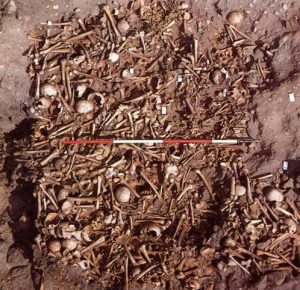February 23, 2018, by Roderick Dale
Repton and the Legacy of the Viking Great Army
By Catrine Jarman, University of Bristol

The Repton charnel burial, (c) Martin Biddle
In 873 the Viking Great Army attacked the monastery in Repton, forcing the Mercian king to flee the country and installing a puppet king in his place. 1100 years later, excavations led by archaeologists Martin Biddle and Birthe Kjølbye-Biddle at St Wystan’s Church in Repton in the 1970s and 1980s uncovered a large defensive ditch, several distinctly Scandinavian graves, and a mound covering a partially ruined building. Inside this, one room was packed with the commingled remains of at least 264 people, around 20 percent of whom were women.
Among the bones were Viking weapons and artefacts, including an axe, several knives, and five silver pennies dating to the period 872-875 A.D. 80 percent of the remains were male, mostly aged 18 to 45, with several showing signs of violent injury. During the excavations, everything pointed to the burial’s association with the Viking Great Army, but confusingly, initial radiocarbon dates suggested otherwise. It seemed to contain a mix of bones of different ages, meaning that they could not all have been from the Viking Age. So who were the people buried in the charnel mound?
In my research, I have used bioarchaeological methods – forensic analysis of bones and teeth – to try to learn about their geographical origins and resolve the confusing radiocarbon dates. I can now show that the original dates were affected by something called Marine Reservoir Effects, where consumption of marine foods made their remains seem older than they really were. I have also been able to use strontium isotope analysis to find out about the geographical origins of this group. Recently, in light of newly discovered Viking camps such as that in Torksey, Lincolnshire, doubts have been cast on the nature and extent of the winter camp in Repton. Results of new excavations can now give us a better understanding of this and also, begin to tell us more about the Viking presence in Repton and the legacy that the Great Army left behind.
Catrine Jarman will give a public lecture about her work on the remains from Repton in the Arts Lecture Theatre A30, University of Nottingham, on 28th February 2018 from 1pm. Although the event is fully booked, you can watch the live stream on the Nottingham Lakeside Arts Facebook page, where you can also catch up with many of the previous lectures.
No comments yet, fill out a comment to be the first

Leave a Reply